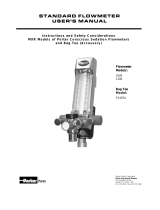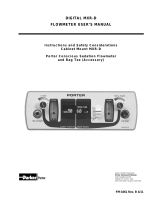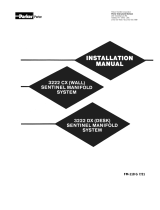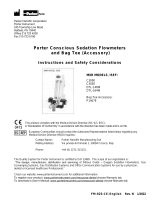Page is loading ...

t
he
outlet
stations
for
every
application
6
200-1
N2O1O2 OUTLET
STATION (CONCEALED)
PORTER O21N2O OUTLET
STATION Stock No.
6200-1
(Exposed Piping Cover Kit
Stock No. 6250K)
PORTER O2 OUTLET
STATION Stock No.
6100-1
(Exposed Piping Cover Kit
Stock No. 6250K)
6200-1 WITH 6250K
N
2
O1O
2 OUTLET
STATION (EXPOSED)
Installation and Instructions
The Porter Outlet Station offers safety, reliability
and
flexibility
of installation. One model outlet station is used
for
all configura-
tions. Features include
the
cross+protection system to prevent
unintentional misconnection to the central piping
system.
Compact stainless steel faceplate is color coded
for
instant gas
identification. A qualified plumber
can
install the outlet
station
by following the details listed in this
brochure.
WARNING
Porter Outlet Stations utilize the cross+protection system. The
copper tubing is diameter
indexed;
3/8” O.D. for Nitrous Oxide
and 1/2” for Oxygen. The cross+protection system is designed
to
prevent misconnection of Oxygen and
Nitrous
Oxide
piping.
DO NOT ATTEMPT TO CHANGE THE DIAMETERS! Tampering
with the cross+protection
system
constitutes acceptance of lia-
bility by the installer. For your own protection, as well as that of
the
Doctor
and the patients, use 3/8” O.D. tubing for all Nitrous
Oxide lines and 1/2” O.D. tubing for all Oxygen lines.
To assure safe operation and conformation to
local
fire
codes, all
Porter Outlet Stations are designed
to
be used with sedation deliv-
ery systems
mounted
inside walls and they meet or exceed the
guidelines established by the National Fire
Protection
Association
for Nonflammable Medical Gas Systems, NFPA 99. Copies of
NFPA 99 or portions thereof may be obtained by writing
to:
National Fire Protection
Association
Batterymarch Park
Quincy, MA
02269-9904
Or call:
1-800-344-3555
6100-1
O2 OUTLET
STATION
(CONCEALED)
6100-1 with 6250K
(EXPOSED)
WARNING
:
Dental workers are exposed to N2O
during
admin-
istration of N2O/O2 conscious
sedation
analgesia. NIOSH has
recommended
that
exposures should be minimized. Contact NIOSH
(1-800-35-NIOSH) to receive NIOSH Publications
on
Control of
Nitrous Oxide in Dental Operatories. Exposure can be minimized by
effective
controls.
National Institute for Occupational Safety and
Health
(NIOSH)
publications state that controls,
including
System
Maintenance, Ventilation and Work
Practices
can effectively reduce
N2O
concentrations
in dental operations. Your Porter Scavenger
System is an important part of the system of
controls.
pg. 1 FM-348 Rev H. 6/11

1 2 3 4
5
pg. 2
6200-1 CONCEALED PIPING INSTALLATION
1. Nail the Outlet Station to a 2 x 4
stud
in the appropriate
location. Leave
the
cover cap on the Outlet
Station.
2. Install the gas supply lines.
Note:
The station is
designed
and
intended to be used with
gas
supply
lines installed using NFPA 99C guidelines. Medical grade
dry
Nitrogen
should be used as a “forming gas” while
soldering. To prevent oxidation inside supply lines:
(a)
Use type K or L,
pre-cleaned,
degreased, capped
copper
tubing
only.
(b) Use 3/8” O.D. for Nitrous Oxide, use 1/2” O.D.
for
Oxygen. DO NOT CHANGE TUBING
DIAMETERS!!
(c)
All copper to
copper
joints are to be made using a
brazing alloy conforming to
AWS*
Classification
BcuP-5 (see AWS Std. A5.8). Flux shall not be used.
(d) Check all joints
for
leaks using dry Nitrogen at 150
PSI until entire system has been tested. Do not use
s
oapy
water—soap contains grease.
(e) Install the manifold and
pressure
test
the entire sys-
tem with
dry
Nitrogen for 24 hours at 60 PSI.
At
the
conclusion of the tests, there shall be no change in
the
test
pressure greater than 5 PSI
drop.
(f) Check for crossed lines.
(Refer
to
NFPA Gas and
Vacuum System Code for Type II Systems) (See
cross+protection Warning in
this
brochure.)
AFTER DRY WALL IS INSTALLED
3. Remove cover cap. Check to make
sure
leading edge
of
box is flush with dry wall. If U
shaped
bracket is incor-
rectly aligned, loosen bracket mounting nuts with a 3/8”
open
end wrench, adjust to fit,
re-tighten
nuts.
4. Alignment & Adjustment for Front
Cover
Plate Installation
—
The Oxygen and Nitrous Oxide Valve Bodies are facto-
ry adjusted to
allow
for
the back of the Front Plate to
press against the metal surfaces of both valve bodies. If
adjustment is needed:
Rotate the Oxygen and Nitrous Oxide valve bodies so
they both
uniformly
contact the back of the Front
Plate when it is installed. Oxygen has right hand
threads
and
Nitrous
Oxide has left hand
threads.
5. Install cover plate so it contacts face
of
wall (and valve
bodies).
6. Connect an 8060 series
duplex
connector and hoses
into
the
completely assembled Outlet
Station.
Attach
the other end of the hoses to a flowmeter and turn the
flow
control
knobs to the off position and
the
on/off
switch to the off
position.
7. Leak test the entire system for working pressure
leaks. Pressurize the sedation gas supply lines with 50
PSI. Observe any pressure decay after 12 hours. This
50 PSI test with the flowmeter
tubing
connections in
place tests the seal
of
the duplex connector extended
into
the o-rings of the outlet
station
primary check
valves. (5 PSI
drop
allowed.)
6200-1 WITH 6250K EXPOSED PIPING INSTALLATION
1 2 3 4 5
1. Bolt Outlet Station to wall.
2. Install the gas supply lines.
Note:
The station is
designed
and
intended to be used with
gas
supply
lines installed using NFPA 99C guidelines. Medical grade
dry
Nitrogen
should be used as a “forming gas” while
soldering. To prevent oxidation inside supply lines:
(a) Use type K or L,
pre-cleaned,
degreased, capped
copper
tubing
only.
(b) Use 3/8” O.D. for Nitrous Oxide, use 1/2” O.D.
for
Oxygen. DO NOT CHANGE TUBING
DIAMETERS!!
(c) All copper to
copper
joints are to be made using a
brazing alloy conforming to AWS*
Classification
BcuP-5 (see AWS Std. A5.8). Flux shall not be used.
(d) Check all joints
for
leaks using dry Nitrogen at 150
PSI until entire system has been tested. Do not use
soapy
water—soap contains grease.
(e) Install the manifold and
pressure
test
the entire sys-
tem with
dry
Nitrogen for 24 hours at 60 PSI.
At
the
conclusion of the tests, there shall be no change in
the
test
pressure greater than 5 PSI
drop.
(f) Check for crossed lines.
(Refer
to
NFPA Gas and
Vacuum System Code for Type II Systems) (See
cross+protection Warning in
this
brochure.)
3. Install #6250K Cover
Kit.
4. Alignment & Adjustment for Front
Cover
Plate Installation
—
The Oxygen and Nitrous Oxide Valve Bodies are facto-
ry adjusted to
allow
for
the back of the Front Plate to
press against the metal surfaces of both valve bodies. If
adjustment is needed:
Rotate the Oxygen and Nitrous Oxide valve bodies so
they both
uniformly
contact the back of the Front
Plate when it is installed. Oxygen has right hand
threads
and
Nitrous
Oxide has left hand
threads.
5. Install cover plate so it contacts
plastic
cover (and
valve bodies).
6. Connect an 8060 series
duplex
connector and hoses
into
the
completely assembled Outlet
Station.
Attach
the other end of the hoses to a flowmeter and turn the
flow
control
knobs to the off position and
the
on/off
switch to the off
position.
7. Leak test the entire system for working pressure
leaks. Pressurize the sedation gas supply lines with 50
PSI. Observe any pressure decay after 12 hours. This
50 PSI test with the flowmeter
tubing
connections in
place tests the seal
of
the duplex connector extended
into
the o-rings of the outlet
station
primary check
valves. (5 PSI
drop
allowed.)
6100-1
Shown Minus
Front
Plate
*American Welding Society
6100-1
W/6250K
PORTER OXYGEN OUTLET STATION
STOCK
#6100-1
EXPOSED PIPING COVER KIT
STOCK #6250K
PIPING INSTALLATION
See installation instructions above (Ref.
6200-1
details).
Disregard any details concerning
3/8”
diameter N2O
piping.

pg. 3
SERVICE PRIMARY AND SECONDARY CHECK VALVE ASSEMBLIES
The Oxygen and Nitrous Oxide primary and secondary check valve assemblies may be field disassembled
and
replaced.
1) Primary Check Valve Assembly O2
A-2689-000
N2
O
A-2690-000
2) Cartridge Body O
2
B-2237-000
N2
O
B-2275-000
3) 016 O’ Ring
PB-102-215
4) Secondary Check Valve Assembly
A-2693-000
5) Compression Spring
PB-115-63SS
SERVICE PRIMARY CHECK VALVE
-
SEE FIGURE 1
May be serviced with station pressurized to 50 PSI.
1. Remove front
plate.
2. Unscrew the primary check valve assembly. Oxygen right hand threads; Nitrous Oxide left hand
threads.
Note: the secondary check
valve will move into position and seal the 50 PSI of the station pressure as the primary check valve assembly is removed.
WARNING: Do not remove the cartridge body while servicing the primary check valve assembly. The secondary check
valve cannot seal the 50 PSI pressure if the cartridge body is removed.
3. Replace the entire assembly.
4. Screw the replaced assembly into the cartridge
body.
5. Alignment & Adjustment for Front Cover Plate Installation
—
The Oxygen and Nitrous Oxide Valve Bodies are factory adjusted to allow for
the back of the Front Plate to press against the metal surfaces of both valve bodies. If adjustment is needed:
Rotate the Oxygen and Nitrous Oxide valve bodies so they both uniformly contact the back of the Front Plate when it is installed.
Oxygen has right hand threads and Nitrous Oxide has left hand
threads.
6. Leak test the entire system for working pressure leaks per the Monthly
Check.
SERVICE SECONDARY CHECK VALVE
-
SEE FIGURE 2
WARNING: To service the secondary check valve, first turn off pressure. Do not remove
the
cartridge body until the pres-
sure is bled off. The secondary check valve cannot seal the 50 PSI pressure if the cartridge body is removed.
1. Turn off pressure at tanks in tank room.
2. Follow procedure to remove primary check valve assembly.
3. Depress secondary check valve further into station block using a small probe or screw driver to bleed off pressure.
4. Unscrew cartridge body out of the station
block.
5. Take a small screw driver or needle nose pliers and insert into holes at the center of secondary
check
valve. Carefully remove check
valve and
spring.
6. Replace the 016 o-ring and secondary check valve parts as required and place in position for reassembly.
7. Screw in the cartridge body and
tighten.
8. Screw in the primary check valve assembly and align and adjust for front plate
installation.
9. Leak test the entire system for working pressure leaks per the Monthly
Check.

pg. 4
3/
5/
CONNECTIONS TO FLOWMETER
-
OPERATING
INSTRUCTIONS
Flowmeter Gas Supply Tubing is connected to the Outlet Station via a quick connect coupler. The Porter 8060 series duplex
connec-
tor simultaneously connects the Oxygen and Nitrous oxide tubing, and prevents the Nitrous Oxide from
being
connected unless
the
Oxygen is
connected.
Quick Connecting: You may quick connect to the station when the system pressure is at its normal 50 PSI; the primary check
valves seal this pressure. The coupler has a locating latch. Simply insert the coupler
into
the appropriate check valve and confirm the
latch
is in place behind the catch feature of the valve. A gentle tug on the coupler will confirm a stable
latch
position. Internally, within the
primary check valve, an o-ring seals against a poppet. The same
o-ring
seals
against the quick connect extensions upon insertion.
Slide the latch out of position to remove
the
connector and the internal poppet will automatically move back into its sealing
position.
Resuscitator: Remove the duplex connector so a resuscitator quick connect may be inserted into the
oxygen
station
position.
MAINTENANCE AND SERVICE
Use scavenging. Monitor for N2O in the operatory to insure that controls are effective in achieving low levels
of
ppm (parts
per
million) exposure. Contact your Porter dealer for details on monitors and
testing.
Inspect and maintain the analgesia delivery system to prevent N2O leaks in all hoses, connections
and
fittings. Repair all leaks
immediately.
MONTHLY
CHECK
Leak test the entire system for working pressure leaks. Connect an 8060 series duplex connector
and
hoses into the
Outlet
Station. Attach the other end of the hoses to a flowmeter and turn the flow control knobs to the off
position
and the on/off switch
to the off
position.
Pressurize the sedation gas supply lines with 50 PSI. Observe any pressure decay after 12 hours. This 50
PSI
test with the flowmeter
tubing connections in place tests the seal of the duplex connector extended
into
the o-rings of the outlet station primary check valves.
(5 PSI drop allowed.) 6200-1 CUT-OUT
FACEPLATE
OUTLINE
CUT-OUT IN WALL
3
8”
2
8”
2 1/4” DEPTH
MIN
3
7/8”
4
5/8”
/












